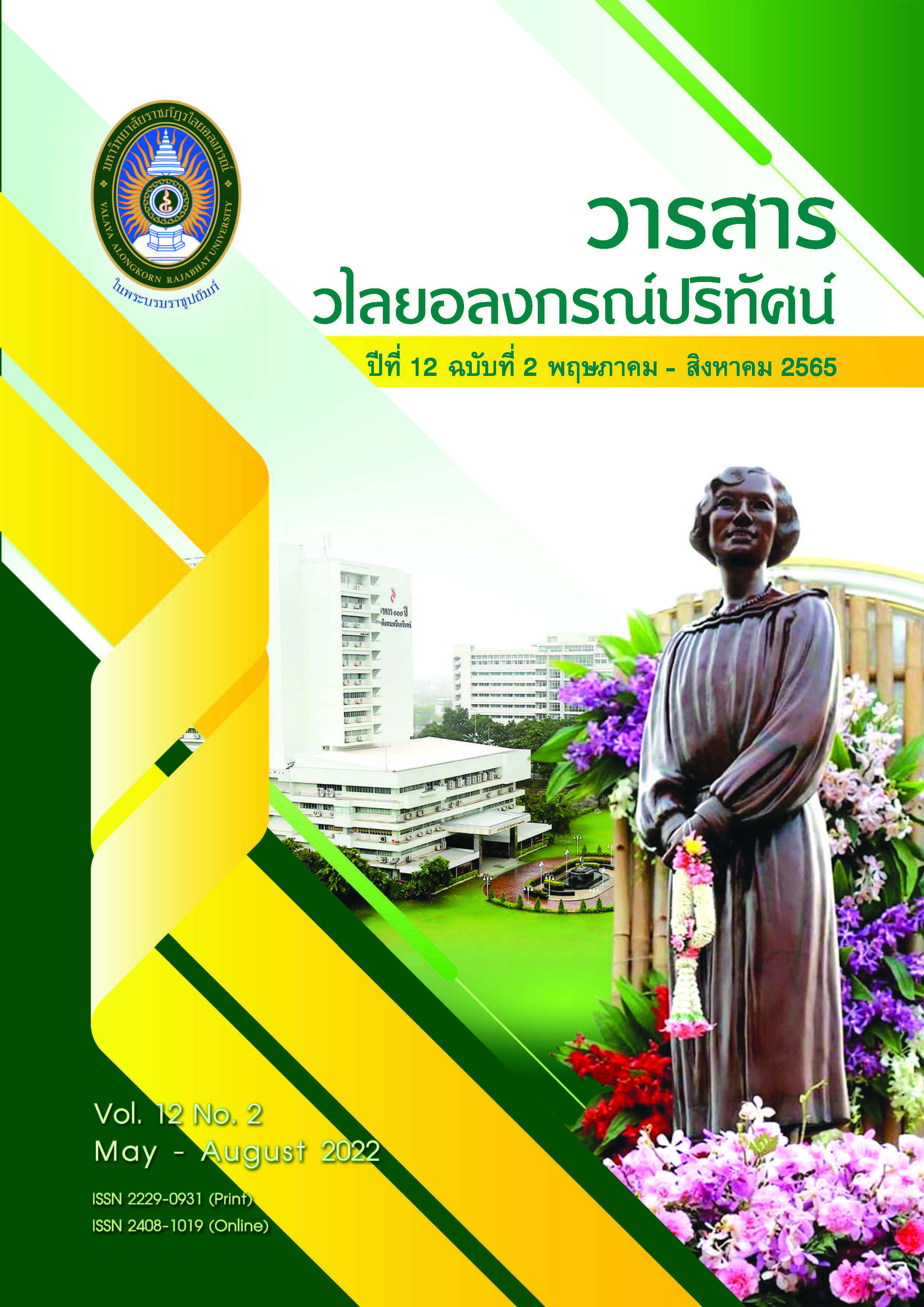แนวทางการพัฒนาการท่องเที่ยวเชิงสุขภาพเพื่อเสริมสร้างความได้เปรียบทางการแข่งขันด้วยการเพิ่มการบริการมูลค่าสูงของจังหวัดสระแก้ว
คำสำคัญ:
การท่องเที่ยวเชิงสุขภาพ, การเสริมสร้างความได้เปรียบทางการแข่งขันด้วยการเพิ่มการบริการมูลค่าสูง, จังหวัดสระแก้วบทคัดย่อ
การวิจัยครั้งนี้มีวัตถุประสงค์เพื่อ 1) วิเคราะห์จุดแข็ง จุดอ่อน โอกาส และอุปสรรค การท่องเที่ยวเชิงสุขภาพของจังหวัดสระแก้ว และ 2) นำเสนอแนวทางการพัฒนาการท่องเที่ยว เชิงสุขภาพเพื่อเสริมสร้างความได้เปรียบทางการแข่งขันด้วยการเพิ่มการบริการมูลค่าสูงของจังหวัดสระแก้ว โดยมีการเก็บข้อมูลกับผู้ให้ข้อมูลหลัก จำนวน 17 คน ที่ทำการเลือกแบบเจาะจงและ แบบก้อนหิมะในขั้นตอนการวิเคราะห์จุดแข็ง จุดอ่อน โอกาส และอุปสรรคการท่องเที่ยวเชิงสุขภาพของจังหวัดสระแก้ว และขั้นตอนการนำเสนอแนวทางการพัฒนาการท่องเที่ยวเชิงสุขภาพ เพื่อเสริมสร้างความได้เปรียบทางการแข่งขันด้วยการเพิ่มการบริการมูลค่าสูงของจังหวัดสระแก้ว และมีการเก็บข้อมูลกับกลุ่มตัวอย่าง จำนวน 370 คน ด้วยการเลือกแบบเจาะจงในขั้นตอนการนำเสนอแนวทางการพัฒนาการท่องเที่ยวเชิงสุขภาพเพื่อเสริมสร้างความได้เปรียบทางการแข่งขันด้วยการเพิ่มการบริการมูลค่าสูงของจังหวัดสระแก้ว เครื่องมือที่ใช้ในการวิจัยคือแบบสัมภาษณ์ จำนวน 3 ฉบับ ที่มีค่าความสอดคล้องที่ 0.97, 0.93 และ 0.93 ร่วมกับแบบสอบถามที่มีค่าความสอดคล้องที่ 0.90 และมีค่าความเชื่อมั่นที่ 0.88 โดยใช้การวิเคราะห์ข้อมูลด้วยการวิเคราะห์เนื้อหา และใช้สถิติที่ใช้ ในการวิเคราะห์ข้อมูล คือ ความถี่ ร้อยละ คะแนนเฉลี่ย และส่วนเบี่ยงเบนมาตรฐาน
ผลการวิจัย พบว่า
1. จุดแข็ง จุดอ่อน โอกาส และอุปสรรคการท่องเที่ยวเชิงสุขภาพของจังหวัดสระแก้ว มีดังต่อไปนี้ 1) จุดแข็ง คือ การมีโรงพยาบาลเกี่ยวกับการแพทย์แผนไทยและการแพทย์ทางเลือกการมีแหล่งท่องเที่ยวทางธรรมชาติและแหล่งท่องเที่ยวที่อนุรักษ์วิถีชีวิตแบบดั้งเดิม การมีแหล่งปลูกสมุนไพรและพืชผักปลอดสาร และการมีโครงการยุทธศาสตร์และแผนพัฒนาจังหวัดที่สนับสนุน การท่องเที่ยวเที่ยวเชิงสุขภาพ 2) จุดอ่อน คือ การไม่มีแนวทางการบริหารจัดการการท่องเที่ยว เชิงสุขภาพ แหล่งท่องเที่ยวบางแห่งยังไม่เป็นที่รู้จักของนักท่องเที่ยว และตำแหน่งสถานที่ท่องเที่ยวค่อนข้างกระจ่ายตัว 3) โอกาส คือ การใช้สื่อทางสังคมออนไลน์และการให้ความสำคัญเรื่องสุขภาพของคนในสังคม และการที่รัฐบาลกำหนดให้จังหวัดสระแก้วเป็นเขตเศรษฐกิจพิเศษ 4) อุปสรรค คือ การรับรู้ของนักท่องเที่ยวเกี่ยวกับการแพทย์แผนไทยและการแพทย์ทางเลือกของจังหวัดสระแก้วที่น้อย สภาพเศรษฐกิจค่อนข้างชะลอตัวและการแพร่ระบาดของโรคโควิด 19
2. แนวทางการท่องเที่ยวเชิงสุขภาพเพื่อเสริมสร้างความได้เปรียบทางการแข่งขัน ด้วยการเพิ่มการบริการมูลค่าสูงของจังหวัดสระแก้ว ประกอบด้วย 4 แนวทาง ได้แก่ 1) แนวทาง การพัฒนาการท่องเที่ยวเชิงสุขภาพตามหลักการวางแผนธุรกิจ 2) แนวทางการพัฒนาการท่องเที่ยวเชิงสุขภาพตามหลักห่วงโซ่แห่งคุณค่า 3) แนวทางการพัฒนาการท่องเที่ยวเชิงสุขภาพตามหลัก การตลาดแบบดิจิทัล และ 4) แนวทางการพัฒนาการท่องเที่ยวเชิงสุขภาพตามหลักเส้นทางของผู้บริโภค ตามลำดับ”
3. รูปแบบการพัฒนาการท่องเที่ยวเชิงสุขภาพเพื่อเสริมสร้างความได้เปรียบทางการแข่งขันด้วยการเพิ่มการบริการมูลค่าสูงของจังหวัดสระแก้วมีความเหมาะสม/ความเป็นไปได้ในการนำไปสู่การปฏิบัติอยู่ในระดับมาก ( = 4.14, S.D. = 0.57)
เอกสารอ้างอิง
กระทรวงการท่องเที่ยวและกีฬา. (2558). รายงานภาวะเศรษฐกิจท่องเที่ยว ฉบับที่ 1 กรกฎาคม - กันยายน 2558. กรุงเทพฯ: สำนักงานปลัดกระทรวงการท่องเที่ยวและกีฬา.
กานดา ธีรานนท์. (2561). การท่องเที่ยวเชิงสุขภาพของประเทศไทย: สถานการณ์และศักยภาพทางการแข่งขันในภูมิภาคอาเซียน. วารสารวิชาการมหาวิทยาลัยฟาร์อีสเทอร์น. 12(ฉบับ Supplement), 22-34.
โกศล จันทร์สมคอย. (2562). แนวทางการวางแผนเชิงกลยุทธ์ในแหล่งท่องเที่ยวท้องถิ่น. วารสารวิชาการธรรมทรรศน์. 19(2): 49-59.
คมสิทธิ์ เกียนวัฒนา และกฤติกา สายณะรัตร์ชัย. (2563). ภาพลักษณ์การท่องเที่ยวจังหวัดสระแก้วเพื่อเป็นเมืองท่องเที่ยวชายแดน. วารสารการบริการและการท่องเที่ยวไทย. 15(2): 3-13.
บุญธรรม กิจปรีดาบริสุทธิ์. (2554). ระเบียบวิธีการวิจัยทางสังคมศาสตร์. (พิมพ์ครั้งที่ 11). กรุงเทพฯ: จามจุรีโปรดักท์.
พีรญา เชตุพงษ์, อารยา บูรณะกูล, กำพร สุวรรณฉิม, ปิยพันธ์ สุวรรณเวช และวิรัลพัชร อสัมภินพงศ์. (2561). การสร้างความได้เปรียบทางการแข่งขันของธุรกิจการท่องเที่ยวเชิงสุขภาพในประเทศไทย. วารสารวิจัยและนวัตกรรม สถาบันอาชีวศึกษากรุงเทพมหานคร. 1(2): 0-97.
สรรค์นันธ์ ตันติอุโฆษกุล อัครวงศ์, รัฐศวรรธน์ กิ่งแก้ว, นิตย์ศรี แสงเดือน, พวงรัตน์ จินพล และวัชราภรณ์ จุลทา. (2563). การพัฒนาการท่องเที่ยวเชิงสุขภาพของจังหวัดนครศรีธรรมราชให้เป็นศูนย์กลางของการท่องเที่ยวเชิงสุขภาพของภาคใต้ตอนบน. วารสารเทคโนโลยีภาคใต้. 13(1), 191-199.
สำนักงานจังหวัดสระแก้ว. (2559). แผนพัฒนาจังหวัดสระแก้ว พ.ศ. 2561 - 2564. [ออนไลน์],เข้าถึงได้จาก http://sakaeo.go.th/oldwebsakaeo/news/news_file/ 103Oct 20161475466688232599plan%204%20(2561-2564).pdf. (2563, 19 มกราคม).
Bernardina Algieri. (2018). International competitive advantages in tourism: An eclectic view. Tourism Management Perspectives. 25(1): 41-52.
Cochran, W. G. (1977). Wiley: Sampling Techniques. (3rd ed). New York: John Wiley & Sons.
Global Wellness Institute. (2017). Wellness tourism. Global Wellness Economy Monitor. 2017(1), 15-25.
Hall, C. M. (1992). Adventure, sport and health tourism. In Weiler, B., & Hall, C. M. (Eds). Special interest tourism (pp. 141-158). London: Belhaven Press.
Heung, & Kucukusta. (2013). Wellness Tourism in China: Resources, Development and Marketing. International Journal of Tourism Research. 15(4), 346-359.
ดาวน์โหลด
เผยแพร่แล้ว
รูปแบบการอ้างอิง
ฉบับ
ประเภทบทความ
สัญญาอนุญาต
ลิขสิทธิ์ (c) 2022 อมรรักษ์ สวนชูผล

อนุญาตภายใต้เงื่อนไข Creative Commons Attribution-NonCommercial-NoDerivatives 4.0 International License.
ข้อความที่ปรากฏในบทความแต่ละเรื่องในวารสารวไลยอลงกรณ์ปริทัศน์ เป็นความคิดเห็นของผู้นิพนธ์แต่ละท่าน มิใช่เป็นทัศนะและมิใช่ความรับผิดชอบของกองบรรณาธิการจัดทำวารสาร และ
มหาวิทยาลัยราชภัฏวไลยอลงกรณ์ ในพระบรมราชูปถัมภ์


